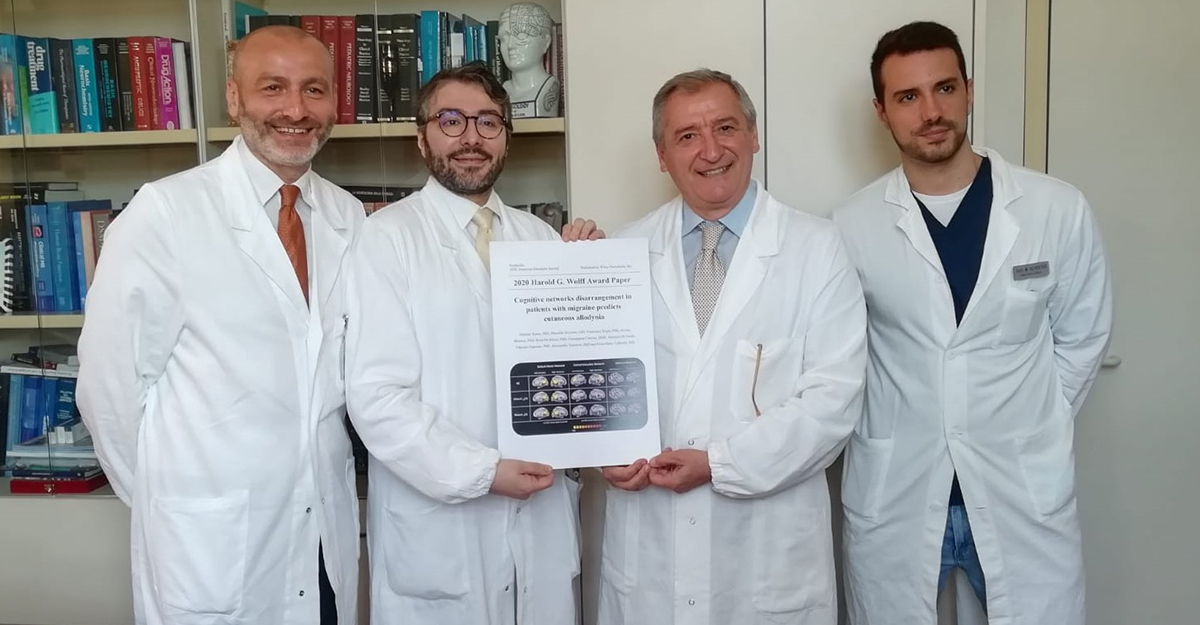IT | EN
A study carried out by a group of researchers of the Vanvitelli University reveals the mechanisms that underlie the phenomenon of skin sensitivity in migraine patients (allodynia) and wins the "Wolff Award", the most important international award in headache research, awarded for the first time to an Italian group by the American Headache Society. A highly coveted recognition by all researchers in the field of headaches, which is added to the Greppi European Award awarded in 2019 to the same research group directed by Gioacchino Tedeschi and formed by Antonio Russo, Alessandro Tessitore and Marcello Silvestro.
The study carried out by the group of neurologists from the Headache Centre of the 1st neurological Clinic of the Vanvitelli University and the Centre for High Magnetic Resonance Studies directed by Professor Gioacchino Tedeschi, shows that this symptom can be predicted even three years in advance. In fact, even before allodynia develops, migraine patients show in their brain, if studied with functional magnetic resonance (so called because it allows us to study not only the "shape" but also the “functioning" of the brain), defects in some brain circuits.
"Allodynia, - explains Tedeschi, full professor of the Vanvitelli University and President of the Italian Society of Neurology - is the feeling that leads the patient, during a migraine attack, to feel pain even for harmless stimuli, such as combing, wearing glasses, earrings or a tie, or simply by touching their face or keeping their hair tied. From a clinical point of view, allodynia is a symptom linked to the progression of migraine. In fact, the symptoms of migraine are not limited to head pain but include nausea, vomiting, discomfort to light, noises and smells and allodynia. When allodynia is present in migraine patients, it represents a predictive factor that informs us that migraine will tend to become chronic. "
“Specifically - clarifies Antonio Russo - associate professor and head of the Headache Centre - this occurs because the cortex of the migraine brain "incorrectly" interprets the painless stimuli applied to the skin during a migraine attack. What has been said is associated with structural and functional anomalies of brain areas responsible not only for the perception and modulation of the painful stimulus but also in the circuits responsible for interpreting the painful stimulus itself ".
The data of the study were presented in the opening ceremony of the international conference of the "International Headache Society" which should have been held in San Diego, but due to the Covid-19 health emergency, was held virtually and was attended by the world's leading experts on headaches.
Currently, this type of advanced analysis is only possible in very few centres - in which both migraine and advanced imaging expertise coexist - therefore it is still not possible to identify on a large scale which patients are destined to a worsening of their migraine several years in advance, however the identification of an alteration of the brain circuits that underlies the chronicization of pain has enormous importance for understanding the intrinsic mechanisms of pain. This study could also concern other types of pain beyond to that of migraine.
Migraine is the most frequent disabling headache in the general population. In Europe, about 136 million people suffer from migraine, of which 6 million only in Italy. The World Health Organization has considered migraine to be the most disabling pathology in the population under 50 as it is considered responsible for the greatest number of years lost due to the disease.





